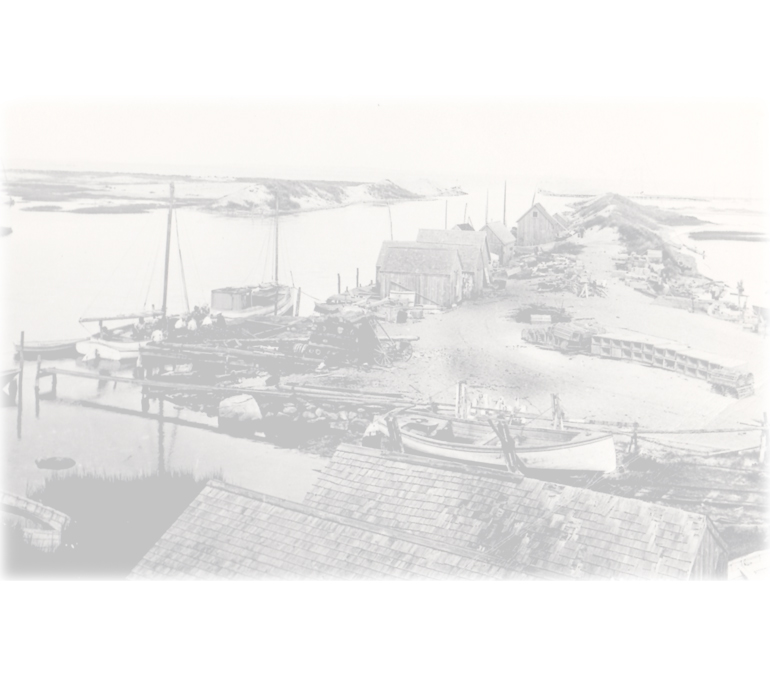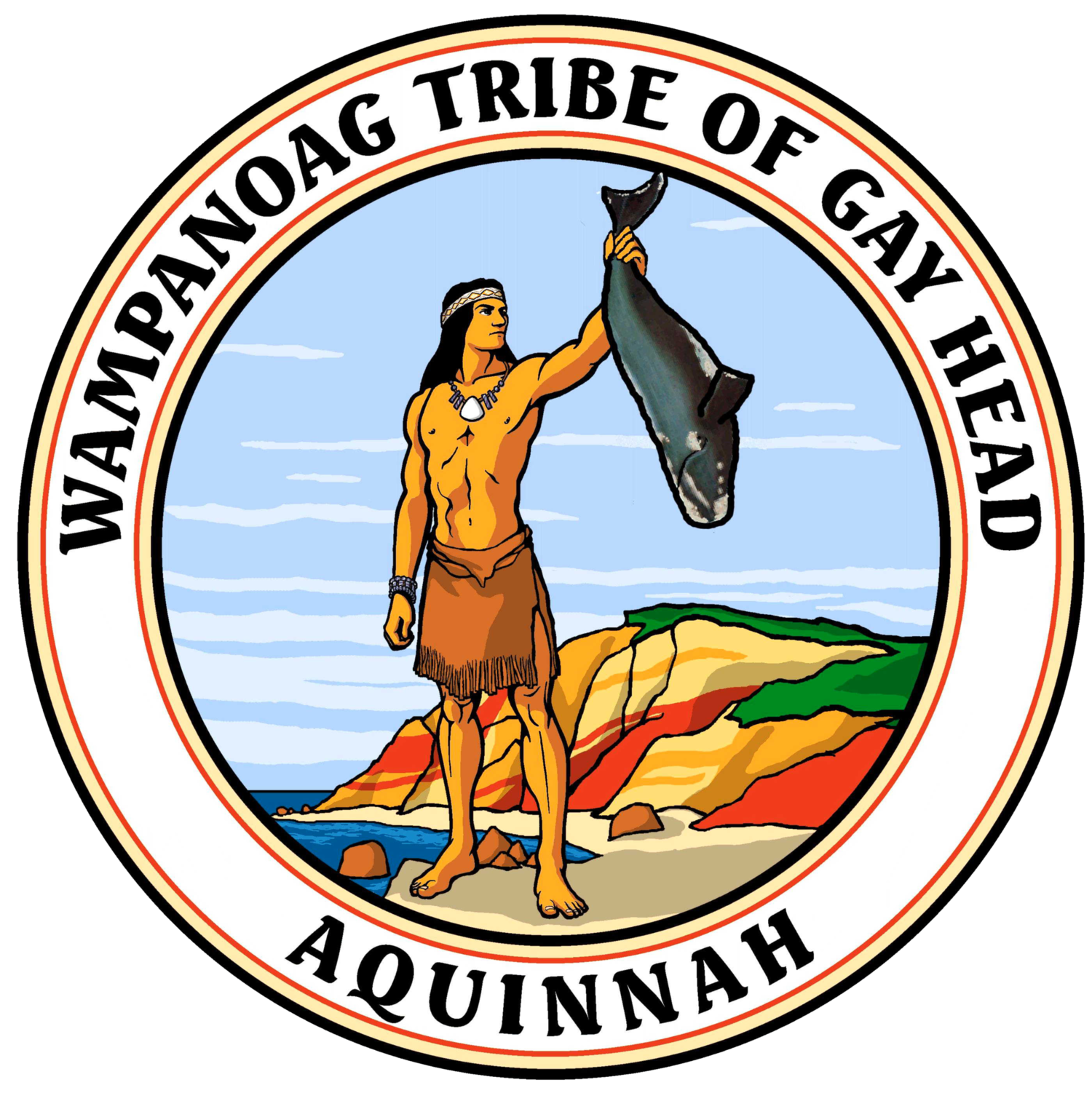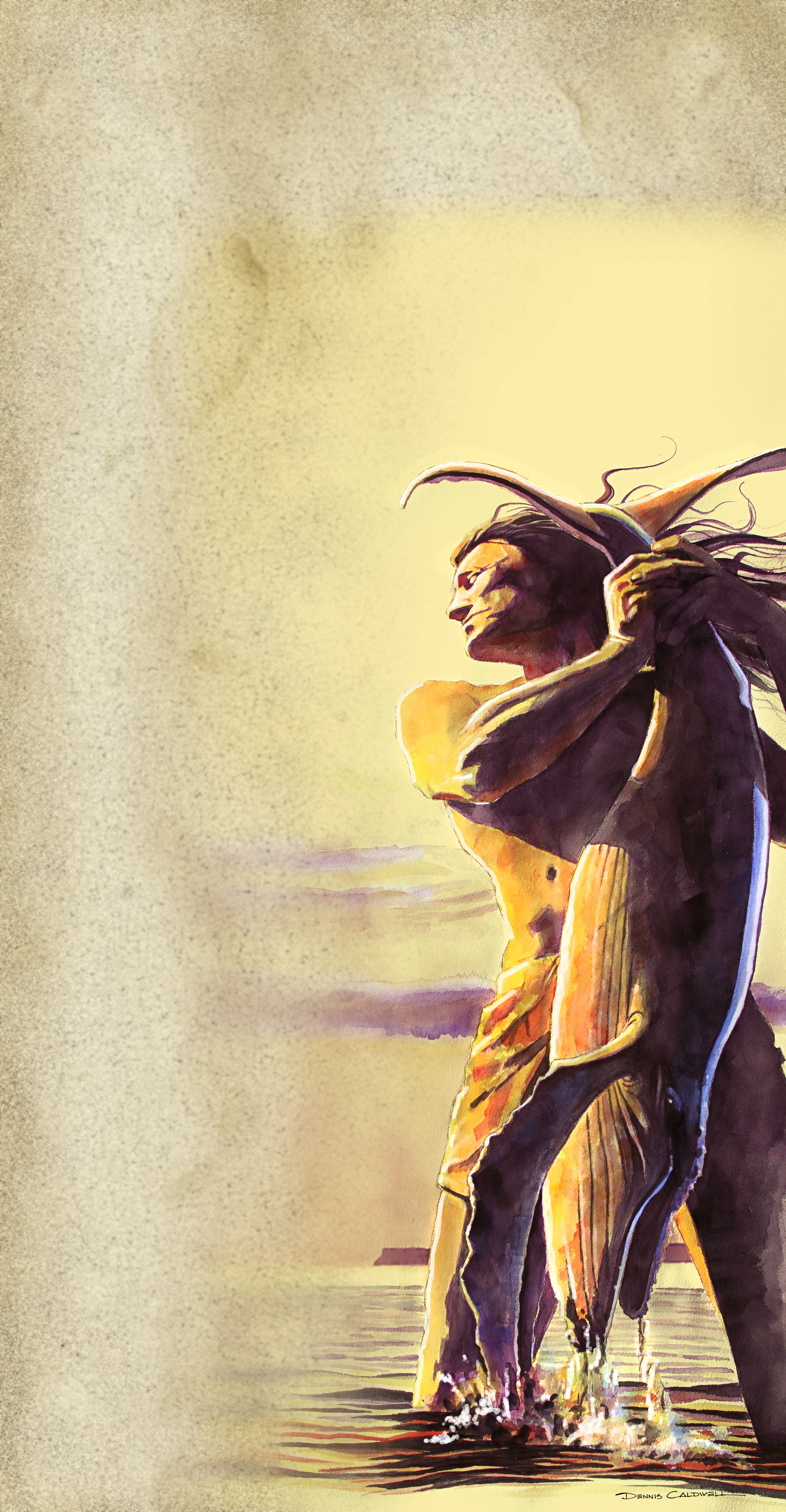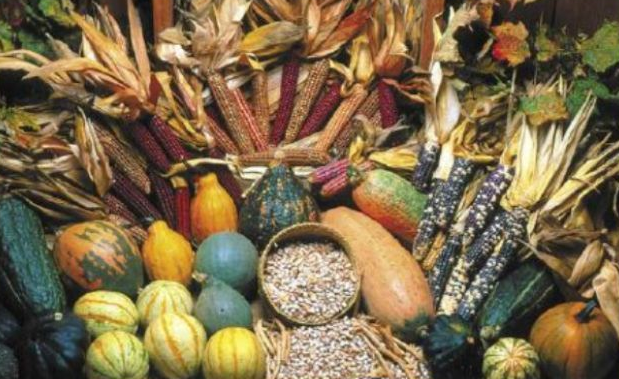
Ancient Ways
The Creation of noepe
Moshup is believed by our tribe to be responsible for the present shapes of Martha's Vineyard, the Elizabeth Islands, Noman's Land, and Nantucket. He is a benevolent being of gigantic frame and supernatural power. He was sometimes thought of as the devil by those who did not understand him. Moshup's favorite daily food was a broiled whale, which he usually ate whole at a meal. He also threw many whales on the coast for the supper of the Wampanoag.
In those olden times, whales came close to shore for they had not learned to fear pursuit. From near the entrance to his den on the Aquinnah Cliffs, Moshup would wade into the ocean, pick up a whale, fling it against the Cliffs to kill it, and then cook it over the fire that burned continually. The blood from these whales stained the clay banks of the Cliffs dark red. The coals of the largest trees (which Moshup plucked up by the roots), the bones of the whales, shark's teeth, and petrified quahogs that are still found today in the Cliffs are the refuse from Moshup's table. The Aquinnah Cliffs are a sacred place to our tribe. They are imprinted with one hundred million years of history.
"Moshup was the first schoolmaster. From his home on the Cliffs he taught the people respect.... He also taught us to be charitable - for when he had great stores of fish he gave of his abundance." --a tribal member
WETU
A wetu is the dome- shaped traditional home of the Wampanoag. It is made of cedar saplings set in the ground, bent together, fastened with vines and inner bark rope, and then covered with bark or mats made of reeds. The roof of the wetu has an opening to release smoke from cooking fires below. Bulrush was used in olden times to make mats that lined the inside of the wetu.
about the artwork
The patterned borders used on this image are taken from traditional basketry and/or painting designs used by the Wampanoag.
Cranberry day - Historical
Cranberry Day is our most important tribal holiday. Long ago, Cranberry Day included many days of harvesting and feasting in celebration of the cranberry harvest. It was held in encampments on the north side of Aquinnah in Lobsterville, where the cranberry bogs are found. Many of our elders tell about the preparation for moving to Lobsterville and how much they looked forward to riding in the ox carts and the singing and dancing that would take place after a long day of cranberry harvesting. There were food tents with quahogs, chowder, venison, and dancing. In those days, the cranberries were then shipped by catboat and traded in New Bedford to obtain goods not found in Aquinnah, like sugar and molasses.
cranberry day - present
Today we continue Cranberry Day in the same spirit and tradition as our ancestors. Each year on the second Tuesday in October, children from Aquinnah Wampanoag families are excused from school to participate in the traditional gatherings of Cranberry Day. Elders harvest with the youth and during lunch, around a large open fire, tell of past Cranberry Days, as well as legends and history taught to them by their elders. During the evening there is a large community potluck with singing and dancing to celebrate and give thanks to the Creator for another year's harvest.
AMOS' GREAT WHITE
Herman Melville immortalized the skill of Aquinnah whalers in his classic novel Moby Dick. Forty years later, life imitated art. Amos Smalley, an Aquinnah whaler, harpooned his own great white sperm whale, the only man who has ever done so. Describing his adventure with the great white, Amos once told a magazine reporter, "He was 90 feet long, three times the length of our boat, and he was unnatural." The Aquinnah Wampanoag in Melville's novel was called Tashtego.
DRIFT WHALES
The Tribe retains to present day their aboriginal rights to any drift whales that beach along or near the shores of Noepe. The whales have been used for their meat, oil, bones - even for the secondary catch of lobsters and crabs that feast on the whale carcass. A skeleton from a juvenile humpback whale that recently washed up on Squibnocket Beach is planned to be included in the future Aquinnah Cultural Center (ACC) museum.
CORN, BEANS, AND SQUASH
Traditionally, corn, bean, and squash were important crops usually planted together by the women of the tribe (and for that reason called "the three sisters"). The broad leaves of corn provided shelter from the sun; the corn stalk was a living stake for the bean and squash vines; and the squash vines provided good cover, ensuring maximum capture of rain and minimum erosion. The beans fix nitrogen in the soil. And all three attract predatory insects that prey upon pests.
CROPS
The tribe recognized the importance of leaving land fallow long before such conservation practices were common. The yearly custom was to hold a meeting and decide where they would plant. They would then turn the livestock out into one pasture and plant in another. A "fence viewer" was employed by the town to ensure that the fences were intact. Spring of the year was Field Day - when all the men would go into the woods, cut fence posts, and put up fences. After that there was dancing and a potluck dinner.
EPENOW'S ESCAPE
Captain Edward Harlow landed on Noepe in 1611 and kidnapped a Wampanoag named Epenow, bringing him back to London. Unfortunately, such kidnappings were common. Epenow devised an escape plan, however. He told his captors of a great wealth of gold on the Island. As hoped, a British expedition was commissioned to return to Noepe in search of these riches - with Epenow along as a guide. Seeing the ship off the shores of Noepe, Epenow's cousins and brothers came out to meet it and devised a plan for Epenow's rescue. Under a hail of arrows, Epenow dove into the water and swam to safety.
THE FIRST NATIVE CONVERT
A young Chappaquiddick Wampanoag by the name of Hiacoome is thought to have been the first native convert to Christianity on Noepe. Hiacoome took an interest in the English-men and their ways - eventually converting to Christianity in 1643. He then helped Thomas Mayhew, Jr. to convert his fellow tribesmen. But Sachem Pahkehpunnassoo of Chappaquiddick objected to Hiacoomes' influence in his area. On a fateful afternoon, however, all this changed. While Pahkehpunnassoo was fixing his chimney, a lightning bolt struck and killed his helper. Pahkehpunnassoo himself narrowly escaped death. Pulled from the flames by one of Hiacoome's converts, he saw this as a sign and converted to Christianity. Slowly, many members of the tribe followed. Hiacoome went on to be ordained and became the pastor of the Meeting House.
FROZEN-IN
Aquinnah Wampanoag Joseph G. Belain spent sixty of his seventy-nine years at sea as a whaleman, first mate, and Captain. In 1897, when whaling in the Arctic, his ship the Nevarch was frozen into the ice. It was Belain who took charge and led the rescue. Using his knowledge of building canoes, Belain built a canvas boat that was light enough to be carried across the ice, but big enough to hold several people. He then carried the Captain of the boat (who had taken sick) to the edge of the ice, where he put him, his wife, and other crew men into his canvas boat and took them ashore to the nearest Inuit village. Inuit canoes were sent out to the frozen-in ship to save the rest.
HARVARD SCHOLARS
A plaque in Harvard Yard commemorates two Wampanoag scholars who were the first American Indians to attend Harvard University. They are Caleb Cheeshahteaumuck, who graduated in 1665, and Joel Iacoomes (Hiacoomes), son of the famous first Wampanoag convert to Christianity. Iacoomes was tragically killed in a shipwreck off Nantucket shortly before graduation. Cheeshahteaumuck died from tuberculosis the year following his graduation.
HAZELNUT
The edible Hazelnut grows inland in woodland thickets. Tea made from its bark is used to treat hives and fevers. A poultice is used to close cuts and wounds.
LAND USE
The Wampanoag approach to land use and ownership was very different from the English settlers. Hunting and fishing lands were divided among the Island's four sachem tribes and were used and lived on seasonally and often cooperatively. As the English arrived, they created laws stating that land that was not occupied by people was not owned. In this way, much Wampanoag land was appropriated by the settlers. As Aquinnah Wampanoag began to understand English law in the 1800s, however, some rented their unoccupied land to the English settlers in order to ensure it remained Wampanoag land.
LEGENDS OF MOSHUP PAGEANT
The Legends of Moshup Pageant is a reenactment of the days when Moshup, a Wampanoag leader endowed with great powers, lived among us. The performance of these traditional stories has spanned several generations. Originally performed in what was once Moshup's cellar hole on the Cliffs, the Pageant is now performed at Boyer's Hill on our tribal lands. In preparation for the Pageant, each participant makes deerhide moccasins, leggings, and skirts and mantles for the women and breech clothes for the men. Dressed in clothes similar to what our ancestors would have worn, our history is told from dusk into the night. From the creation of Noepe to Moshup's farewell, the Wampanoag of today remember Moshup, Squant, and our ancestors - relations of long ago.
"In the forties, we built bonfires to light the action of the Pageant and performed against a white cliff. You could see these figures performing and dancing against the cliffs."
--a tribal member
A RECOMMENDED SELF-GUIDED TOUR
We invite you to take the following tour, which includes some highlights along Wampanoag Way. These sites are all marked and relatively easy to find. The entire tour can take a couple of hours or all day - depending on how leisurely you want to pace yourself. Going by bike? Take the bike ferry from Menemsha to West Basin, then begin this tour.
Stop 1: Lobsterville
Begin your tour by visiting Lobsterville, where there are beautiful views of the Basin. Notice the cranberry bogs on tribal lands to your right, looking much as they did hundreds of years ago.
Stop 2: West Basin
Bear left and head toward West Basin, where you can book a fishing charter or just ponder the view of Menemsha.
Stop 3: Aquinnah Town Center
Go back out Lobsterville Road to State Road and make a right turn, heading down to the center of Aquinnah, where you can see the Town Hall, Gay Head School and the Gay Head Community Baptist Church. Still in use today, this church continues to be central to the lives of tribal members.
Stop 4: The Aquinnah Cliffs and Aquinnah Light
Head out to the spectacular Aquinnah Cliffs where you can enjoy a picnic lunch of lobster rolls or other local food nestled on the grass at Aquinnah Circle. (The stores along the Cliffs are also a great place to buy native pottery, art, jewelry, wampum, or other souvenirs of your stay.) Or take a stroll along the path down to the beach below to see the Cliffs up-close and take a swim in the surf, if you wish. Before you leave, don't forget to check in at the Aquinnah Lighthouse to see if tours are happening that day.
Stop 5: Alley's and 7a
End your tour with a stop at Alley's General Store - and Back Alley's 7a - where you can find other Island treats, mail your postcards, or just sit on the porch and watch the world go by.
ROSE HIPS
Rose hips are used by the tribe to this day to make teas and jams and are also eaten as a fruit. They are very tart, but high in vitamin C. Wild roses grow in all types of habitats - in swamps or pond edges, as well as open scrub areas. The Beach Rose that grows along the dunes is currently the major source for rose hips. It is not native, but was introduced from Japan and brought by whale ships.
SASSAFRAS
Sassafras is found in dry, open woods. The root bark, twigs, trunk bark, and leaves of this tree have been used medicinally and for a bitter tea. Handmade wooden mortars, used for grinding corn for nokehick (a traditional corn cake), were also made from the Sassafras wood.
SCRUB OAK
Scrub Oak is one of the dominant trees on the Island. Crops are planted when the scrub oak leaf buds are the size of a mouse's ear (when they are just beginning to leaf out) and the shad bush is in bloom. Plants are often used as important indicators of the weather and seasonal changes.
SEASIDE GOLDENROD
Seaside Goldenrod (or Beach Goldenrod) is characteristic of salt-water creeks and marshes. It can be grown elsewhere if fertilized with seaweed or eel grass. The yellow flowers have been used by the tribe for dye.
SQUANT
Early in the morning, when tribal fisherman sometimes see an immense track in the wet sand where the tide has gone out they say "Ol' Squant has been along."
SUGGESTIONS FOR COURTEOUS BEHAVIOR
Welcoming visitors has always been a central Wampanoag value and an important part of Island life. But you may not be aware of certain restrictions we have to protect both our island and our culture. Please read the following carefully and follow any posted signs. We hope these suggestions will make your visit on tribal lands more enjoyable and respectful for everyone.
* Do not pick up or remove any artifact or objects of archeological importance. There are strict federal regulations against this.
* Alcohol, weapons, and drugs are not permitted on tribal lands.
* It is prohibited to take clay from the Aquinnah Cliffs, climb on them, or otherwise disturb the Cliffs in any way.
* Please visit only the tribal multi-purpose building when on tribal lands. All other areas are not open to the public.
* Please respect private homes, property, and all "no trespassing" signs.
* Please do not pick wildflowers, plants, berries, etc.
* Please remember to dispose of all your trash.
TOAD ROCK
According to tribal history, Toad Rock was a giant pet toad that Moshup turned into stone before disappearing from Aquinnah. The stone was used as a "post office" of sorts for Tribal members, who placed notes to each other on the rock when they passed by.
TRIBAL LANDMARKS
Tribal landmarks and their names are often natural - a rock, a tree, a waterway, or even a ridge of a hill. The limits of sachemships were marked off by such natural boundaries. This method extended to many of the boundaries later drawn by the European settlers. The European settlers, however, more often paid homage to people rather than to nature when they named places.
WILD CRANBERRIES
Wild cranberries, or sasumuneash in Wampanoag, grow naturally on 200 acres of tribal land. They grow in acidic wetland areas with sandy soils where sphagnum moss also grows and forms a layer of peat. The tribe opens patches in the dunes called swales to promote growth. However, out of respect for the land, the cranberries are neither fertilized, nor sprayed.
WINGED OR DWARF SUMAC
Winged or dwarf sumac is purple and is found in dry woods and clearings. Tea made from its bark can be used as a wash for blisters. Tea from its root was used by the Wampanoag to treat dysentery.







